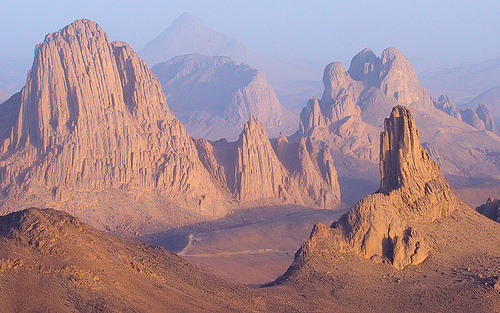

Location: Tamanrasset Province Map
Area: 3,800 km²

Charles Eugène de Foucauld
1858- 1916
Hoggar National Park is an extensive protected reserve that protects unique biosphere of Ahaggar Mountains. It covers 3,800 km² in the South Algeria. Hoggar National Park is located in the South Algeria and cover large expanse of Hoggar Mountains in the Sahara Desert Highlands. Bizarre and picturesque shapes of the mountains were formed due to volcanic activity centuries ago. Its highest point is Mount Tahat at an elevation of 2918 meters above seal level.
Climate in Hoggar National Park is continental. It is hot and dry in summers, while in winters the temperature might drop below freezing. Keep in mind that nights in Sahara desert are generally speaking very cold. Even after hottest day temperature can drop significantly.
Hoggar National Park was historically inhabited by Tuareg tribes. Their kingdom known as Kel Hoggar was established in the middle of the 18th century. In 1903 like much of North Africa, Tuareg came to a protectorate of France. Many French priests and monks came here to preach Gospel, help people or simply leave in solitude among foreign and beautiful Hoggar mountains. The most famous resident of Ahaggar National Park was French Catholic father Charles Eugène de Foucauld founder of Little Brothers of Jesus. He became locally known as a wise and descent man who helped people of all religions and walks of life. Unfortunately on December 1, 1916 father Charles was shot and killed by passing Bedouins. He was beatified on 13 November 2005 by Pope Benedict XVI.
Its highest mountain (2908
m) is the Tahat in the Atakor volcanic field. The Hoggar is known
for its bizarre rocky landscapes, with its distinctive elevations
being eroded volcanic vents. The Hoggar lies at the level of the
Tropic of Capricorn, about 1500 km south of the Algerian capital
Algiers. At 543,900 km², its area is roughly the size of France. The
area is mostly inhabited by Tuaregs. The largest oasis in the
Ahaggar region is Tamanrasset. Other inhabited oases are Ideles,
Hirhafok, In Ekker and Tit.
The summit of Mount Assekrem is a
particularly popular place because Charles de Foucauld built a
hermitage there in 1911.
In the 1960s, In Ekker was the
nuclear test site of the French nuclear weapons program in Algeria.
Radioactive fallout contaminated the site and large swathes of land.
The Hoggar Mountains are located in the eco-zone of the tropical / subtropical arid areas and are also continental due to the great distance to the coast. This leads to an extremely dry, fully arid desert climate with hot summers and cold winters, which is exacerbated by the altitude. Nevertheless, even here the negative atmospheric temperature gradient leads to temperatures 0.5 to 0.8 ° C colder per 100 meters and thus to condensation of rising air masses. While it gets cold below 0 ° C on around 39 days at 1,400 meters, it is already 114 days a year at 2,700 meters. Temperatures down to −5 ° C occur in the summit region. The differences in the amount of precipitation are only slight compared to the plain, as the air mostly contains almost no water. Rain falls sporadically at best and is a rarity. Nevertheless, a biodiversity has developed that has been able to promote a biodiversity that has hardly been preserved.
Somewhat north of the Hoggar in the Teffedest Mountains, the African wild dog, which appears in various rock engravings, survived until the 20th century. However, it now seems to have been eradicated in this region. Cheetahs are extremely rare.
Numerous rock carvings are known from the Hoggar. Archaeological sites document the settlement since the Paleolithic. There are rock paintings and engravings that suggest that prehistoric settlements as early as 6000 BC. Were present. The Ahaggar massif is particularly the habitat of the Kel Hoggar. The tomb of Tin Hinan, an ancestor of the Tuareg at the Abalessa, is near Tamanrasset. She was the mythical ancestor and the first queen of the Ahaggar-Tuareg and founded the Kel Hoggar community in the region.
The Hoggar Mountains consist primarily of mountains of volcanic origin. Even in the high elevations of the Hoggar region, only dry valleys can be found. One of them can be assigned to Wadi Igharghar. Today the region forms a national park in Algeria.